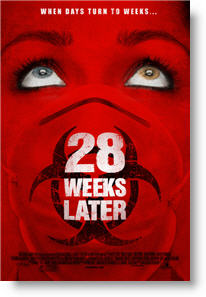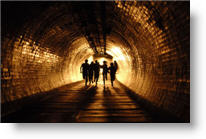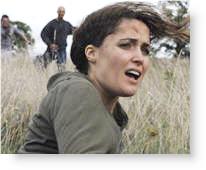28 Weeks Later
 for strong violence and gore, language and some sexuality/nudity.
for strong violence and gore, language and some sexuality/nudity.
Reviewed by: Chris Sosa
CONTRIBUTOR
| Moral Rating: | Extremely Offensive |
| Moviemaking Quality: |
|
| Primary Audience: | Adults Teens |
| Genre: | Horror Sci-Fi Sequel |
| Length: | 1 hr. 39 min. |
| Year of Release: | 2007 |
| USA Release: |
May 11, 2007 (wide—2,000 theaters) |









| Featuring |
|---|
|
Jeremy Renner Robert Carlyle Rose Byrne Catherine McCormack Harold Perrineau Jr. |
| Director |
|
Juan Carlos Fresnadillo |
| Producer |
|
Andrew Macdonald Alex Garland Danny Boyle |
| Distributor |
 Fox Searchlight Pictures, a sister company of 20th Century Fox, a division of The Walt Disney Company |
“It all begins again”
“28 Weeks Later” is the follow-up to the extremely popular independent film “28 Days Later”. For those unfamiliar with the previous film, “28 Days Later” put a spin on the zombie genre in which a group of infected humans spread their highly contagious virus to other humans causing them to have uncontrollable, indefinite fits of rage in which they kill all human beings.
This installment takes place 28 weeks after the first occurrence of infection, just as society is beginning to return to normal, all the infected are dead from starvation, and refugees are slowly but surely arriving in Britain. The American Army has arrived to help with the relief efforts, and all seems to be going well… that is, until the virus resurfaces.
In terms of content, the most obvious concern of this film will be the violence, and I suggest that any readers easily sickened skip to the next paragraph. It is difficult to explain exactly how horribly disgusting this film actually is. I have reviewed more than one truly disgusting film, but this was by far the most unsettling. While the other films had a clear break with reality, “28 Weeks Later” did not. The violence was sickening in its brutality. One such scene found an infected man slashing his wife, eventually forcing his thumbs into her eye sockets, which in turn killed her. This is only one of many truly unsettling violent segments. The scenes of extreme violence were simply too many to record, and each one had a very, very dark and unsettling tone, somewhat odd for a genre that never seems to quite have a grip on reality. If one were to find the aforementioned scene even slightly unsettling, they would be best served skipping this film.
The second-most concern will be the sexual content. While paling in comparison to the violence, it is present. One scene shows a couple having sex, and their top-halves are exposed. Limited other scenes contain moderate-level nudity in a non-sexual context.
Strong language is present, but is nowhere near the level of many other current films. While language is one of the least of this film’s content concerns, there are multiple instances of the harshest of language.
From a spiritual viewpoint, this film offers more food-for-thought than actual answers. The most obvious and direct showing of Christian principles comes during one of the movie’s later scenes, echoing the Biblical principle, “There is no greater love than to lay down one’s life for one’s friends” (NLT).
Other points in the film make for better conversation starters than specific spiritual lessons, themes such as the nature of humankind, survival vs. sacrifice, the consequences of scientific advancement, and the effect of America on the world. This film does not appear to have any concept of God, positive or negative.
Lastly, there is no way for one to speak of “28 Weeks later” without referencing its incredibly slick presentation. The mood was consistently tense. The cinematography had a very gritty yet controlled feel to it, and the pacing was purely genius. Not to mention, the score of this film was chilling, sometimes so minimalist as to have the audience squirming in their chairs due to the extreme tension.
The special effects were also amazing, with the infected looking more like something out of a nightmare than make-up from a studio. Whoever directed this film deserves a shot at the Academy Awards, as a horror film of this caliber has rarely been seen since Romero first introduced the world of cinema to true terror in his masterpiece “Night of the Living Dead”.
So in closing, “28 Weeks Later” is difficult to describe. From a stand-point of social concern, this film should have probably gone from the editing room to the garbage. From an artistic stand-point, the world of cinema may have a modern-day classic on its hands. This is what makes the film so confusing. I really wanted to enjoy it, but found it difficult. I attempted throughout the entire film to think of one socially conscious reason to justify its existence, but I came up with nothing. Art should be a medium used responsibly, but this film was anything but responsible. The only positive thing to be said from a socially-conscious viewpoint about “28 Weeks Later” is that through its intricate plot, it makes us take a look at ourselves, and we’ve never seemed in such need of redemption as in this film. Thankfully someone was up to the task.
Violence: Extreme / Profanity: Heavy / Sex/Nudity: Heavy
Q & A
 Every time you buy a movie ticket or buy or rent a video you are in effect casting a vote telling Hollywood, “I’ll pay for that. That’s what I want.” Read our article
Every time you buy a movie ticket or buy or rent a video you are in effect casting a vote telling Hollywood, “I’ll pay for that. That’s what I want.” Read our article- Learn about DISCERNMENT, wisdom in making personal entertainment decisions
See list of Relevant Issues—questions-and-answers.


There was no real attempt to convey a specific, direct message… just food for thought. Symbols such as a statue of Washington, the cross atop a church, eyes, children etc., can be analyzed into infinitum to create greater meaning, but deep thought beyond “Humans are bound to doom themselves” is pointless. The music was grand in its intensity and energy, it, along with the stunning visual effects is worth the watch for mood and atmosphere. Great artwork makes one feel, and this is exactly what the movie “28 Weeks Later” does.
Moral rating: Better than Average / Moviemaking quality: 4½
Like Jesus had when he was willing to die for the sins of man, not that the acts in this movie can compare to jesus, but it’s heroic to see one give his life to save another, especially to overcome evil or make a positive difference. If you liked the first one, I would say that you would also enjoy this film also, but don’t bring the kids.
Offensive / 4
Everything good about “28 Days Later” was ruined in “28 Weeks Later” (except for the gritty style and the creative camera work). While I never had to look away from the first film, I found myself looking away from “28 Weeks Later” a lot. Forget the creepiness and implied violence of the first film, 28 Weeks was sickeningly gory and absolutely drenched in blood: a woman takes off her face (sort of), in one especially horrible scene, an infected man brutally (and I do mean brutally) kills his bound wife, heads explode, lots of chewing and biting, another woman has her face beaten in etc. (There was a notable amount of violence toward women in this film—tells you something about the guys that made it.) There was no point or reason for these scenes at all.
The first film was smart because it showed you only what was needed, whereas this film was like every other zombie horror film in the sense that it was just a gore fest for the sake of pleasing debased audiences. I am a very objective person, if the gore or violence has a point, than O.K. There was no point in this film.
Secondly, the whole 1 hr, and 40 min. long running time was cheaply used as an anti-American allegory on the war in Iraq. The American soldiers are camping out in London, to help the people “reconstruct,” but wind up slaughtering innocent people later. The American flag is slyly show more than once in a negative way including one brief instance of the words “errorism” emblazoned on it. Also, a bust of George Washington overlooking a streetful of dead Englishers gunned down by Americans was angrily shown.
As far as the nudity, it was non-sexual and used for sympathetic effect and like the nudity in the first film, I thought it was necessary. The “Rear Window” type voyeuristic sniper who spies on the couple having sex was quick and brief, not necessary, but not really a big deal.
For those of you uncomfortable with harsh language, 28 Weeks had far less swearing than it predecessor. (I’ve heard that people in England swear more than Americans—this was from a Brit.)
As for the most important aspect of the movie, the story was stupid. I understand that 28 Weeks had to come off as a “middle movie” but much of the moral dilemmas it could have gone into was wrecked by the short running time used up gratuitous bloodletting. In a nutshell, this film was far, far less a smart, “what would you do” film than 28 Days. On a positive note, 28 Weeks did feature great character development and very believable characters. I did like the complex character of the father however horrible (this took a bold writer to create a character like this) and the character development of the brother and sister. There are some valuable lessons about humanity to be gained from this film. But nowhere near the extent of the first film.
The camera work and frenetic editing, brilliantly used by Danny Boyle in 28 Days, is copied by the new guy who directs 28 Weeks, the terseness and gritty camera work was genius. The absence of sound was terrifying when it was used as well as the pitch black scenes. (The nightvision scene had my skin crawling) The famous theme song was sadly overused in this film—the best part was the beginning at the cottage.
All and all, the only thing to be gleaned from “28 Weeks Later” is its characters, the brief questions about humanity and survival, and its style. To sum up, 28 Weeks was a, frankly, a gore fest and offered very little besides. If you liked the first one for the reasons I stated, don’t see this one. If you are considering seeing 28 Weeks and haven’t seen its predecessor, rent it, turn out the light, and enjoy. Forget about “28 Weeks Later.”
Very Offensive / 5
It was pure filth. I don’t think a zombie that kills people and eats people should go to heaven, but they may end up in heaven if they commit no sin: this, however, is not addressed with enough detail in this film. bringing this zombie afterlife into more focus may bring about a moral spiritually uplifting message to this rather nihilistic film.
Moral rating: Extremely Offensive / Moviemaking quality: 1
I also think the gore was a little much in this movie, following the Hollywood trend of having gore simply for the sake of gore. The last thing I have to say is I hope if some massive infection like this were to break out, the military won’t just lose it and start killing everyone infected or not (that is NOT a country I want to be a part of).
Average / 5
Many will not be able to stomach the brutal violence of the scenes, and yes this movie is brutal in many places. But if you can get past the brutal violence and moderate level of language (although I’ve read that there are 28 f-words, it did not seem that many were spoken), then you will find an extremely well done, intense, heckuva thrill-ride. But be warned, like I said it is BRUTALLY violent!
Extremely Offensive / 5

 Why is the world the way it is? If God is all-knowing, all-powerful, and loving, would He really create a world like this? (filled with oppression, suffering, death and cruelty)
Why is the world the way it is? If God is all-knowing, all-powerful, and loving, would He really create a world like this? (filled with oppression, suffering, death and cruelty)
Impressed by recent British films helmed by acclaimed foreign directors, “The Constant Gardener” (2005) and “Children of Men” (2006), directed by Fernando Meirelles and Alfonso Cuarón respectively, I decided to give this one a go.
I was not disappointed, right from the frantic opening scene, filmed using handheld cameras for the most part; I could tell that this was going to be a much more satisfying film than its predecessor. After the heart-pounding opening the viewer is then treated to possibly the best cinematic framing of the city of London (albeit a post-apocalyptic one) that I have ever seen. When one’s eyes aren’t feasting over the sumptuous cinematography, then one is gripped by the superbly executed horror, suspense and action sequences, making for a thrilling viewing experience.
The film is also much more intellectually rewarding than its predecessor as it can also be viewed as a political allegory, not unlike George A. Romero’s cult classic “Dawn of the Dead” (1978)—a satire on consumerist America. The military that now patrol the desolate streets and rooftops of London, on the lookout for stray zombies, are American and have an almost flagrant disregard for the people of the country they are patrolling. This is clearly a not so subtle reference to the US presence in Iraq and Afghanistan. This takes added resonance when these soldiers are ordered to take indiscriminate military action against an isolated area of the city, even using their own version of cluster bombs.
Regardless of one’s political view over US foreign policy, this aspect of the film is thought provoking nonetheless and raises the film to a higher level than others typical of this sub-genre.
However, for all its artistic merit, this is not a film that I would recommend to the majority of Christian movie-goers as the levels of gore and violence are quite extreme and the foul language is ever present. Viewer discretion is definitely advised.
My Ratings: Very Offensive / 3½